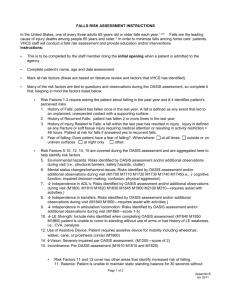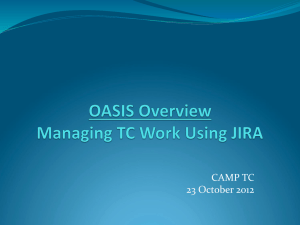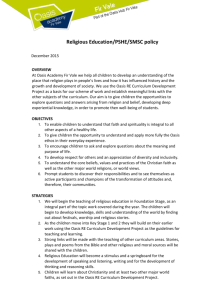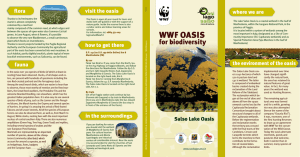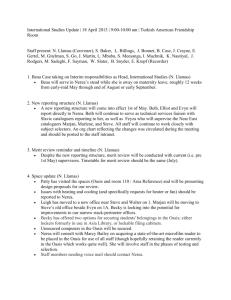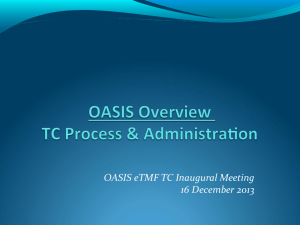Respite in the desert - International Hot Spring Hotel
advertisement
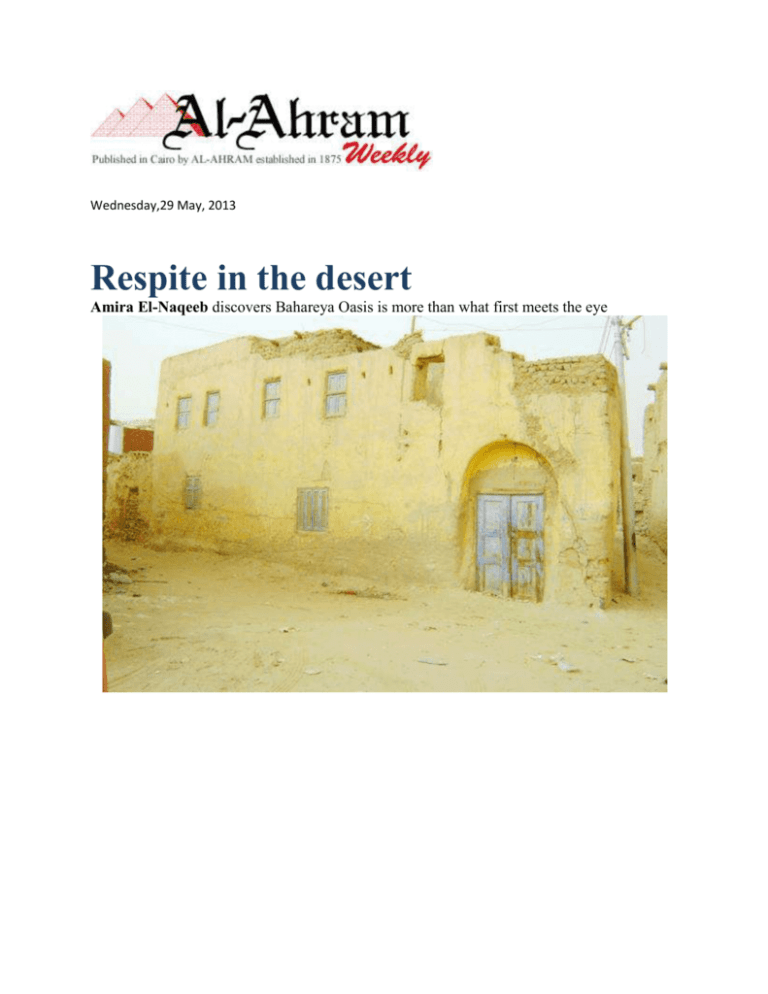
Wednesday,29 May, 2013 Respite in the desert Amira El-Naqeeb discovers Bahareya Oasis is more than what first meets the eye Print Email Al AHRAM Weekly English on 28/05/2013 Bahareya Oasis has always been a stopover for travellers heading to the Black or the White Desert. Situated in a depression about 100km by 40km and completely surrounded by high black escarpments, it has been known since ancient times as the Northern Oasis. It takes about three and a half hours by car to cover the distance of 350km from Cairo, and is considered the closest oasis to the capital. Bahareya Oasis boasts lush palm trees and verdant fields, standing in contrast to golden sand dunes and cinnamon-coloured hills. It is home to several villages, most prominently AlBawiti, Al-Qasr, Harrah, Mandisha, Zabw and Hayz in the southern most part. Al-Bawiti is the capital and the oasis’s largest village. Until recently, little was known about Roman history at Bahareya which was mostly based on a large volume of Roman papyri found at Oxyrhynchus (Al-Bahnasa). The ancient documents reveal the oasis was occupied by Roman troops of the larger contingent there. Tamer Al-Sayed, an avid Egyptologist and owner of an ecolodge at Bahareya, told Al-Ahram Weekly that the existence of many Roman ruins and an elaborate aqueduct system suggest the oasis was heavily populated during this period. In March 1996, a guard riding his donkey from the Temple of Alexander stumbled on a hole in the sand which turned out to be a tomb. This began an excavation which subsequently led to an astonishing discovery of a vast necropolis containing possibly as many as 10,000 well- preserved mummies dating back to Graeco-Roman times. Some were wearing spectacular golden facemasks. “Bahareya now has one of the most important archaeological sites in Egypt, and is famous around the world for its Valley of Golden Mummies,” Al-Sayed explained. The Museum of Golden Mummies houses some of these mummies. One of the most recent discoveries was in 2010 when a Roman-era mummy was unearthed in Harrah village. It was of a woman covered in plaster and decorated in what resembled Roman dress and jewellery. The mummy can now be viewed at the Museum of Golden Mummies. Almost all hotels at Bahareya organise daily tours, which include an orientation tour of the oasis to give visitors a sense of the place. The streets of Bahareya are mostly narrow and garnished with green fields on both sides. Sometimes if the street is too narrow palm trees form a canopy that allows very little sun to come through. Watching the sunset by Maamoor Lake is unforgettable, so make sure not to miss it. Close to the lake is the area of Al-Dest wal-Maghrafa, where you can cut across the small tabletop mountains, and take a sneak peak at Wahati (native oasis) fields and houses. Close to this area is Pyramid Mountain where the Bahareyasaurus (Bahareya lizard) was discovered. The huge theropod was found at Bahareya Formation and its remains can be viewed at the Geological Museum in the Cairo suburb of Maadi. Another mesmerising archeological site is the Tombs at Qarat Qasr Salim (Salim’s Palace), also known as Bannentiu Tomb. The tomb, dating back to the New Kingdom of the 26th Dynasty, is located about four metres underground and can be reached via steps leading to the entrance. Upon entering, one finds most of the drawings in the tomb are well preserved and colours and characters are bright and vivid. There are four tombs used as burial sites during Roman times. The Chapels of Ayn AlMuftillah are four chapels that also belong to the 26th Dynasty. In her book Islands of the Blest, a Guide to the Oases and Western Desert of Egypt, Cassandra Vivian writes one chapel was discovered by Steindorff in 1901, and the other three excavated by Egyptian archaeologist Ahmed Fakhry. The walls of the chapels are made of sand stone which made carving easy. While the colours of the murals are not as vivid as those at Bannentiu Tomb, there are more inscriptions inside that are well worth seeing. Gabal Al-Ingliz (English Mountain), located in Al-Bawiti, got its name because British colonial soldiers spent a long time on this mountain, and built a building from basalt rocks to use as a watch tower. Since this is one of the highest peaks over Bahareya, it was ideal for surveillance and monitoring strangers or intruders coming to the depression, especially the Sinosy tribes of Libya. Today, all that is left are ruins of the watch tower believed to date back to the 1800s. Gabal Al-Ingliz can be visited on foot — just rent a 4x4 to take you very close to the foot of the mountain where you can climb up to the see the remaining walls. The area was declared a natural protectorate by Egypt’s Ministry of Environment in 2010. The ancient village of Al-Qasr, formerly the capital of Bahareya in Pharaonic times, has clearly lost much of its lustre. Compared to Al-Qasr at Dakhla Oasis, there is not much to see at this one except some relics. Nonetheless, a stroll in the orange and apricot groves was enjoyable, especially if you can pluck your fruit snack right off the tree. Although Al-Bishmu Roman Spring is not the best sightseeing opportunity, walking around Al-Bishmu you can see some abandoned old houses that embody the unique distinct architecture of the oasis in earlier times. A contemporary museum was recently built by one of the locals to offer a glimpse into how life once was, and showcase oasis traditions and culture. Bahareya is also famous for its handicrafts; the women of Al-Agooz village make a variety of embroidered bags, tablecloths and pillowcases. A woman’s traditional dress at the oasis is called galabiya, which Vivian describes as “the most beautiful in the Western Desert”. She portrays it as “a black loose fitting garment falling to well below the knees, with straight long sleeves. The bodice of the dress is the most highlighted part, where it’s embroidered in red and yellow cross-stitch with authentic Islamic coins sewn into the pattern below the breast.” Baharia Handicraft Shop is a joint venture between the Bahareya branch of the Ministry of Social Solidarity and Japan International Cooperation Agency (JICA). The project aims to support Bahareya women by helping them sell their products in the shop, and teaching them how to make beauty products such as olive oil soap and lip balm. Umm Mohamed is one of the skilled women at Al-Agooz village, who complained that business is not going well. “Unfortunately, since the revolution we sell nothing because of the few tourists who come to visit,” she explained, while displaying some of her impressive work. Bahareya residents are a mix of original oasis dwellers, Bedouin tribes of the Western Desert, and families who migrated from Middle Egypt and the Nile Valley. Most Wahatis are Muslims and their customs are a mix of religion and tradition. In Al-Bawiti, the community seems more conservative and most women will cover their faces when they leave the house. In Al-Agooz, meanwhile, the culture seems less rigid and women can meet strangers, trade their handicrafts and do not have to cover their faces. For a genuine cultural experience, visitors and foreigners can easily be invited into one of the local homes for dinner or lunch. These visits can be organised through hotels and a local guide will usually accompany the guests. According to custom, women will eat in a separate room than men and shoes are not worn inside the house. Walking languidly through the fields of Bahareya not only cures one’s soul and unwinds the coils of the mind, but the natural springs in Bahareya also offer a true wellness experience. The natural hot springs are rich in minerals, especially sulphur which helps cure various skin diseases and arthritis. There are only two hotels in Bahareya that house natural hot springs in their gardens. There are also different types of hotels and lodgings at the oasis that cater for different tastes and budgets.

